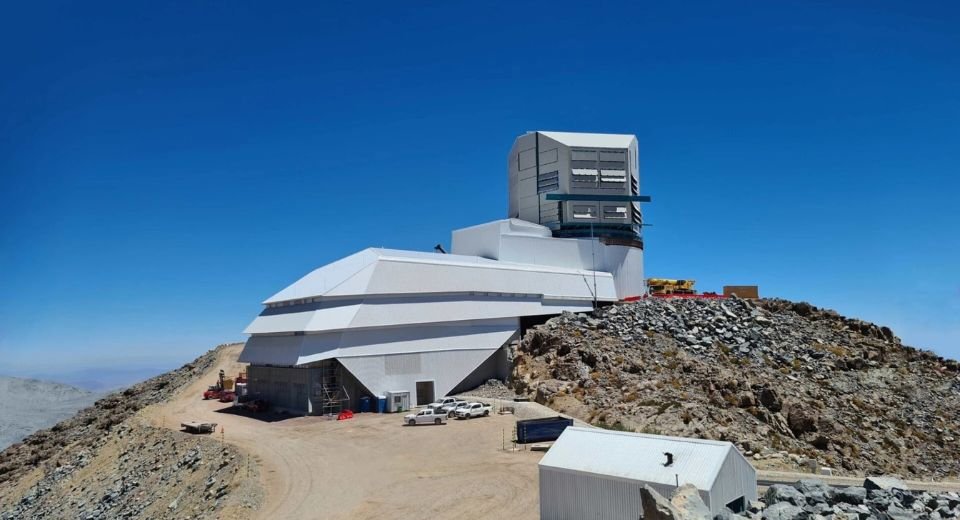HQ Team
January 3, 2025: A $549.6 million observatory, situated on a mountaintop in Cerro Pachón in Chile, will start operations by October in an attempt to provide the first convincing evidence for the existence of dark matter.
The NSF–DOE Vera C. Rubin Observatory an astronomy and astrophysics facility named after astronomer Vera Rubin, who provided the first convincing evidence for the existence of dark matter, is currently under construction.
The 8.4-meter Simonyi Survey Telescope at the observatory is equipped with a Legacy Survey of Space and Time camera — the largest digital camera ever built.
It will take detailed images of the southern hemisphere sky for 10 years, covering the entire sky every few nights and creating an ultra-wide, ultra-high-definition, time-lapse record — the largest astronomical movie of all time.
Scientists will study the explosions of millions of dying stars and use the light from these events to measure cosmic distances and study dark energy’s effect on the universe’s expansion.
Mysterious force
Dark energy is the mysterious force causing the Universe to expand faster than expected based on gravitational theory.
The observatory will bring the night sky to life, yielding a treasure trove of discoveries — asteroids and comets, pulsating stars, and supernova explosions.
Over 10 years, Rubin could change our understanding of how and when the universe was formed.
It will rapidly scan the night sky to capture the largest sample of Type Ia supernovae yet, unlocking new insights into the nature of dark energy.
Scientists will ask questions such as: Is a brighter star closer to Earth than another, or is it just emitting more light? To make confident distance measurements, scientists rely on objects that emit a known amount of light, like Type Ia supernovae.
White dwarf
In a Type 1a supernova, a leftover core of a Sun-like star (called a “white dwarf”) pulls material from a nearby star until it explodes.
These explosions, among the brightest to ever be recorded in the night sky, result from the violent deaths of white dwarf stars and provide scientists with a reliable cosmic yardstick.
Their brightness and colour, combined with information about their host galaxies, allow scientists to calculate their distance and how much the Universe expanded while their light made its journey to us.
With enough Type Ia supernovae observations, scientists can measure the universe’s expansion rate and whether it changes over time.
The observatory, funded by the US National Science Foundation and the US Department of Energy’s Office of Science, is estimated to discover more Type Ia supernovae in the first few months of using the Legacy Survey of Space and Time camera.
10 million alerts
Scientists said seeing supernovae once or twice is not enough as “there is a goldmine of information in how their fleeting light varies over time.”
Every night Rubin Observatory will produce about 20 terabytes of data and generate up to 10 million alerts — no other telescope in history has produced a firehose of data quite like this.
It has required scientists to rethink the way they manage rapid alerts and to develop methods and systems to handle large incoming datasets.
“The large volume of data from Rubin will give us a sample of all kinds of Type Ia supernovae at a range of distances and in many different types of galaxies,” said Anais Möller, a member of the Rubin/LSST Dark Energy Science Collaboration
“The universe expanding is like a rubber band stretched,” she said. “If dark energy is not constant that would be like stretching the rubber band by different amounts at different points.”
‘Generational shift’
“I think in the next decade we will be able to constrain whether dark energy is constant or evolving with cosmic time. Rubin will allow us to do that with Type Ia supernovae.”
Rubin’s deluge of nightly alerts will be managed and made available to scientists through seven community software systems called Fink.
The software systems collect the alerts from Rubin each night, merge Rubin data with other datasets, and, using machine learning, classify them according to their type, such as kilonovae, variable stars, or Type Ia supernovae, among others.
Scientists using one of Rubin’s community systems, like Fink, will be able to sort the massive dataset of alerts according to selected filters, allowing them to quickly hone in on the data that are useful for their research.
“Rubin is a generational shift,” Möller said. “And our responsibility is developing the methods that will be used by the next generation.”
